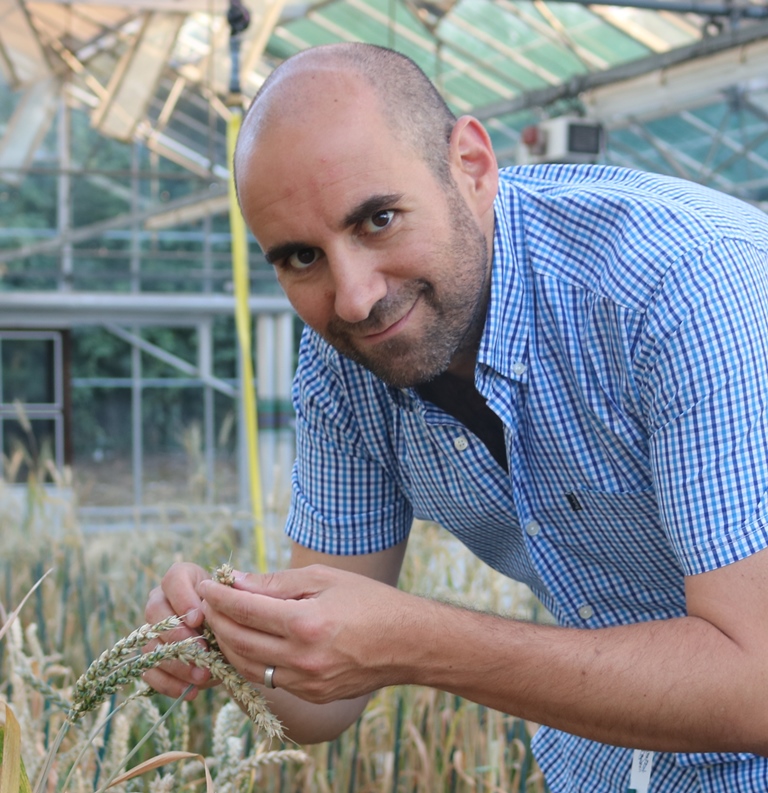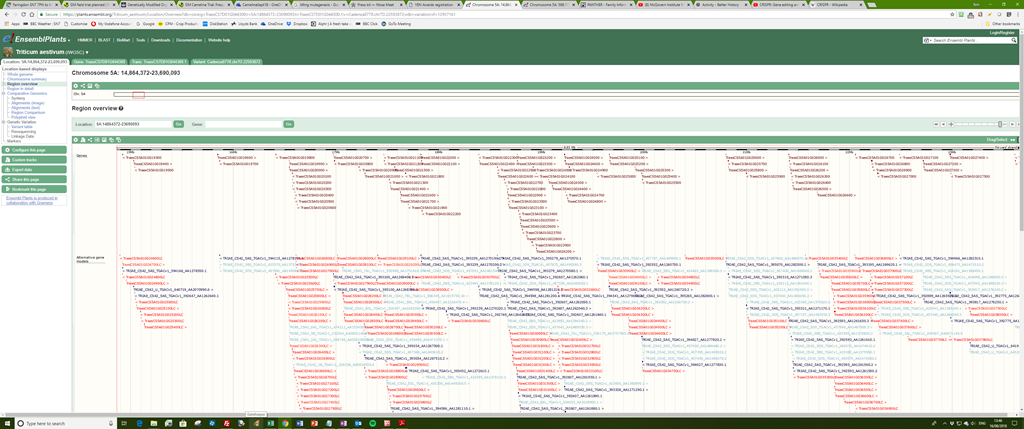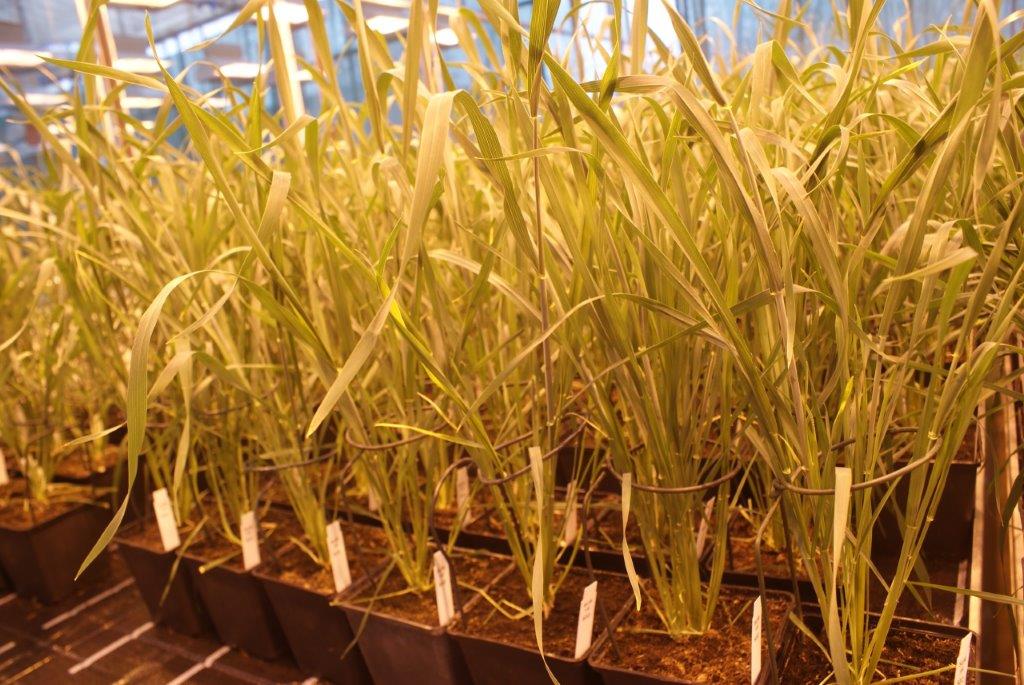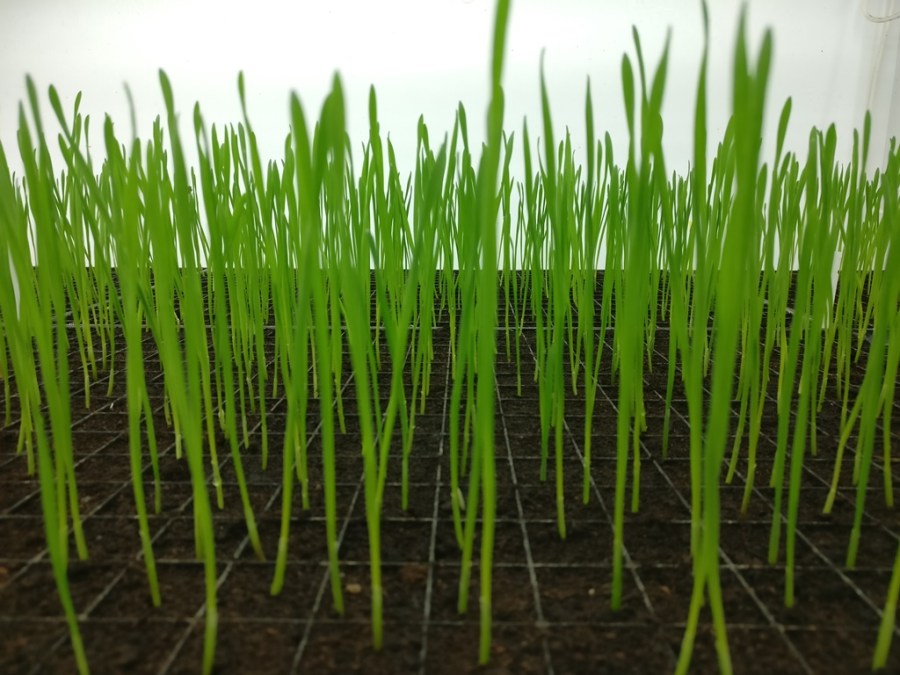Ground-breaking research, led by John Innes Centre in Norwich, is set to deliver a step-change in wheat productivity, but now it hangs in the balance. CPM visits to get a masterclass in gene-editing.
We can really accelerate where we take these wheats, but the law will severely restrict how we develop them in the EU.
By Tom Allen-Stevens
You’re taken from one screen that has rows upon rows of letters, some of them highlighted, to another that has coloured bars with more coded letters spidering out in an exploded diagram.
Prof Cristobal Uauy, project leader in crop genetics at the John Innes Centre, Norwich, is flicking through the pages of EnsemblPlants, web-based software that provides a window on the wheat genome. On the screen is apparently the genetic code of Cadenza0778.chr5A.1593872, a mutant of the spring wheat variety, and Cristobal’s explaining how the flowering switch works and how a natural mutation knocks out the vernalisation requirement of a winter wheat.

Prof Cristobal Uauy
“It’s a specific gene and there’s a protein that represses it, preventing the plant from flowering until it’s been through the right weather conditions. But just one mutation in that gene means the protein cannot find the site to bind to and the plant will start to flower – it’s just so elegant.”
What is perhaps just as elegant is the tool he’s using. It helps plant breeders and scientists find their way through the 16 billion base pairs – building blocks of DNA – that make up the large and complex wheat genome. Putting it together has involved 200 scientists from 73 research institutions in 20 countries and it details the sequence of the 21 chromosomes, the precise location of 107,891 genes and more than four million molecular markers.
This enormous dataset, providing the complete sequence of the wheat genome, was published for the first time in the middle of last month. Scientists claim it will accelerate innovation in breeding resilient and disease-resistant crops to feed a growing global population, although much now depends on how legal moves at an EU level play out.
“Work that used to take us many months to complete, now can be done in just a few minutes – this is the future of wheat mapping,” enthuses Cristobal.
Wheat genome
What’s made sequencing wheat such a huge challenge is not just its enormity, he explains – wheat has three sub-genomes and a large part is composed of repetitive elements. This means that vast parts of the genome are very similar, if not identical, to each other, making it difficult to distinguish each sub-genome and to put together the genome into its correct order.
The actual variety that’s been completely mapped, end to end, is a wheat called Chinese Spring. But this is helping UK scientists, such as Cristobal, find their way around British varieties. “Before, we didn’t know where the pieces go and now we do,” he explains.
“Now we can match a sequence for Claire, Robigus, Cadenza, and the many other varieties UK researchers are currently working on. It’s helping us, bit by bit, work out not just where the genes are, but sequence information between them containing the regulatory elements influencing the expression of genes.”
And this is where the really exciting part lies for the 35-40 research groups across the UK involved in the BBSRC-funded Designing Future Wheats (DFW) programme (see panel below). This collaborative pre-breeding effort has an expanded brief from previous research, developing ‘toolkits’ with novel germplasm for commercial breeders and genetic markers to help identify traits.
“Marker-assisted breeding is nothing new, but what’s improving all the time is the definition,” explains Cristobal.
Phenotypic traits, such as disease resistance, are traced to areas of the genome known as a quantitative trait locus (QTL). When breeders make a cross, they can use the marker to test for the presence of the QTL in the resulting lines. “The difficulty is that the cross brings in a lot of unwanted DNA with it, and breeders have to spend many generations tidying it up,” he continues.

Publishing the wheat genome is set to accelerate innovation in breeding resilient and disease-resistant crops to feed a growing global population.
“As our understanding of the wheat genome develops, what we’re moving to is the perfect marker, that tags just the specific gene or the mutation we’re interested in.”
Genetic mutations take place out in the field naturally all the time, he explains. It’s where a break takes place in a plant’s DNA, induced by stress, or UV light, and it then repairs itself. “Usually the repair is good, but sometimes the plant makes a mistake, which alters the nature of the gene or shuts it off completely. But this can be a good variation – the trick for the breeder is spotting them in the field.”
For centuries, it’s these that breeders have used to build in variation and thereby develop interesting traits. “Perhaps the most famous natural mutation in wheat was the reduced height or dwarfing gene (Rht). The potential of this was realised by Norman Borlaug and paved the way for the Green Revolution,” notes Cristobal.
Mutagenesis
Mutations can also be induced through mutagenesis (see panel below). Golden Promise and null-lox varieties have come as a result of mutagenesis in barley as has the Clearfield trait in oilseed rape.
“The difficulty in wheat has always been that it’s a hexaploid crop type with three sub-genomes. With a lot of traits, particularly the more complex ones, associated with yield and drought tolerance, for example, you have to affect the relevant gene on each sub-genome simultaneously. It’s a bit like having a room with three lights – you have to flick off all three switches to make the room dark.”
That’s not always the case, he continues, and the flowering trigger is a good example of where a mutation in just one sub-genome will bring about the phenotypic variation. “But the random nature of old mutagenesis techniques has always meant that scientists have struggled to develop many useful traits in wheat.”

As a hexaploid crop type with three sub-genomes, breeding traits into wheat often involves having to affect the relevant gene on each sub-genome simultaneously.
There is one trait that the team at JIC has been working on and is showing real promise, however, reveals Cristobal. “It’s a trait developed through EMS mutagenesis that affects grain width. We have mutant lines of Cadenza spring wheat that we’ve been working on and now have material that has a significant difference in thousand grain weight (TGW).”
That’s not necessarily a difference in yield, he stresses. “But it’s a change in sink capacity that’s significantly higher than you’d get through normal lines coming through the AHDB Recommended List. We now need to work with farmers to see if we can develop a different agronomy package that can translate it into higher yields.”
These mutant Cadenza lines are now with commercial breeders to bring the trait through into RL lines.
But this is just a taste of what’s to come – further work on phenotyping and genotyping, bolstered through a greater understanding of the wheat genome, has helped Cristobal and his team zero in on the part of the wheat genome responsible for the trait.
“We’ve identified TaGW2 gene homologues on each of the three wheat sub-genomes that are negative regulators of grain size and thousand grain weight. We’ve mutagenised each gene copy in Paragon spring wheat to switch off the gene. We have also worked with Kansas State University to use CRISPR-Cas9 and generated similar mutants via gene-editing.”
Higher thousand grain weight
Plants with just a single mutation showed a TGW increase of 5.5%, while double mutants resulted in a 12.1% increase. “The highest increase in grain size and TGW came from triple gene-edited mutants with a 20.7% higher TGW.”
Further work needs to be done with the germplasm before it can come out into the field or into commercial lines, notes Cristobal. But the whole project now hangs in the balance. “The new ruling means any release of the gene-edited material in the EU must be covered by GMO regulations. The really frustrating part is that now we have the wheat genome, we can really accelerate where we take these wheats, but the law will severely restrict how we develop them in the EU.”
Coming through the research pipeline is a raft of other work looking at traits where significant steps forward in disease resistance and resilience to environmental factors, such as drought, have been made through CRISPR techniques.
“The really exciting part is that now we don’t have to cut, close our eyes and hope for the best. We can be more precise – we know where our targets are and can deliver a neat and clear edit.”
And with the most recent advances in research, the time to get an edit into RL lines could be cut dramatically, says Cristobal. “We can take a gene defeated by yellow rust and repair it. In a few years from now, we’d be able to take a leading variety, edit the genes to improve it and have it back with the breeder with 12 months – that’s where the technology’s heading and we have the talent and the funding here in the UK to deliver it.” All that’s needed is the legal framework and the political will.
Toolkits bring novel wheats to breeders
The aim of Designing Future Wheat (DFW) Programme is to deliver new useful genetic variation and knowledge to breeding. Funded by BBSRC, it’s brought together scientists from JIC, Rothamsted Research, The Earlham Institute, University of Bristol, EMB-EBI, NIAB, University of Nottingham and Quadram Institute of Bioscience.
“The nice thing about the programme is that we’re working more closely with Rothamsted, NIAB and others. We used to be more siloed, but now we’re working together,” says Cristobal Uauy.
DFW is a step on from the Wheat Improvement Strategic Programme (WISP), a public-funded pre-breeding programme aiming to increase the diversity of traits available to UK wheat breeders. “WISP looked at landrace varieties, synthetic hexaploid wheats and wild relatives to introduce novel germplasm and bring back useful traits lost from modern varieties,” he explains.
“That work has been subsumed into the much larger and more ambitious DFW. We’re doing far more genotyping and phenotyping and there’s work on data access and analysis.”
The programme is divided up into four distinct work packages:
- WP1: Increased efficiency and sustainability (led by Rothamsted) – this involves genetic improvements in yield traits, as well as in tolerance to abiotic and biotic stresses. There’s high-throughput phenotyping, genetic dissection of key traits and development of the germplasm.
- WP2: Added value and resilience (led by JIC) – this involves enhancing grain quality for human health, combating non-communicable diet-related diseases and improving the resilience of wheat production systems to biotic stresses. One aim is to increase the amount and bioavailability of essential micronutrients, such as iron and zinc, in wheat grain.
- WP3: Germplasm development for trait dissection (led by JIC) – this accelerates the discovery and deployment of genes and alleles of high value for breeding. It advances the genomic characterisation of foundation germplasm and validates the new genes, alleles and markers for their value in breeding.
- WP4: Data access and analysis (led by Earlham Institute) – this involves new sequencing experiments, and the development of an informatics infrastructure to provide a comprehensive, federated, and open data portal. It forms the UK national node of the global Wheat Information System and builds into the publicly available sequenced wheat genome.
Particularly promising germplasm is multiplied and trialled at commercial breeders and scientific institutions, provided through a breeders’ diversity toolkit (BTK). This is a major new output for DFW and comprises pre-breeding germplasm with information on interesting traits and genetic markers to help breeders identify these. Output from WP1 and WP2 is now taken forward to pre-breeding through the WP3 BTK.
Lights stay on for speed breeding
Researchers from JIC have collaborated with those in the University of Queensland, Australia, to develop protocols for rapid generation advancement, dubbed ‘speed breeding’.
“By manipulating the light regime, we’ve been able to achieve significantly accelerated generation times for a large range of crop plants, including wheat,” notes Cristobal.
Up to six generations can be bred in a single calendar year, in special temperature-controlled, LED-lit growth rooms. It allows a faithful study of a range of adult plant phenotypes and then for the plants to be crossed far more efficiently than glasshouse-grown plants. It also more than halves the time taken for scientists to develop novel germplasm and new traits.
Evolution of mutagenesis
New breeding technologies (NBTs), such as CRISPR, have greatly accelerated advances in mutagenesis. While most authorities around the world, notably the USA and China, have accepted mutagenesis as part of normal plant breeding, the recent ruling by the Court of Justice for the EU (CJEU) has paved the way for most techniques to come under the EU’s GMO regulations.
- Generation 0 – ‘old’ mutagenesis: For around 80 years, scientists have been inducing mutations artificially, exposing plants to radiation or chemicals such as ethylmethanesulfonate (EMS). These processes have the effect of causing many different mutations that can then be screened to find useful traits. While confirmed by CJEU as exempt from EU GMO regulations, it’s seen as an imprecise, even random technique, that still requires a lot of work in subsequent screening and filtering out unwanted genes. More recently TILLING (Targeting Induced Local Lesions in Genomes) has been used to help scientists identify and select for particular traits in mutant lines. DFW germplasm generated using this technique is now with commercial breeders and in trial plots.
- Generation 1 – CRISPR-Cas9: Introduced in 2013, this has been used in wheat for just three years (see explanation here). It involves the introduction of DNA, classed as a transgenic step, to express an RNA guide that locates specific places on the wheat genome, while the Cas9 enzyme cuts the host DNA at set locations. The transgenic DNA is not taken through to the next cross, making the resulting germplasm indistinguishable from naturally mutated lines. The transgenic step brings it within EU GMO regulations, however, and this has now been confirmed. While the location is precise, the resulting mutation is more random, and can result in the deletion or insertion of a few bases which disrupts the normal functioning of the gene. Wheat germplasm has been developed in the UK with this technique but it is still at least two years from requiring field trials.
- Generation 2 – Cas9 alternatives: This technique still uses CRISPR as the guide RNA, but different enzymes or proteins can be used to perform different tasks. Significantly, very precise edits to the host DNA can be made with relative ease – with the publication of the wheat genome, scientists are now investigating how they can turn disease susceptibility into resistance, for example. This still involves a transgenic step, however.
- Generation 3 – biolistic delivery: This technique was published by Chinese scientists in Feb this year. It involves DNA-free editing of the wheat genome through in vitro transcripts or ribonucleoprotein complexes of CRISPR-Cas9. Essentially, no foreign DNA enters the host plant, so there’s no transgenic step. What’s more, a reduction in off-target effects is claimed. While arguably exempt from EU GMO regulations, the new ruling brings this and any subsequent forms of mutagenesis within their scope. UK researchers are currently bidding for funding to explore this area in wheat. By using these protocols, plants precisely edited without the use of any foreign DNA can be generated and identified within 9–11 weeks, claim scientists.




